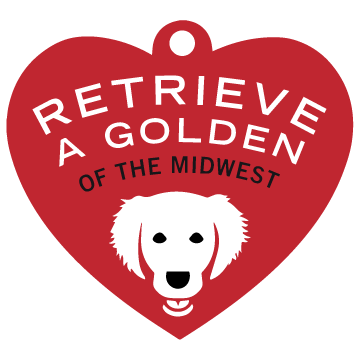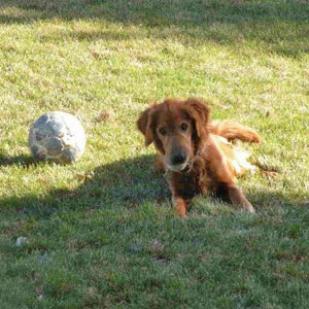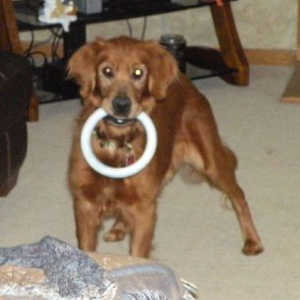First, a big THANK YOU for the "mitten!" Very kind of you and we thank you. We can use all the help we can get. Maizy is not spayed and has a severely cracked upper canine which needs to be removed. She requires insulin, syringes, repeated blood checks, and a special diet as well. It all mounts up so quickly and we have just a wonderful vet here. Again, here are links to help if you can:
http://www.ragom.org/donations/donations.html
http://www.ragom.org/donations/ways_to_help.html
This medical situation will be a new learning curve for us as we are not real familiar with diabetes in dogs whatosever. So, I would like to share our learning experience with the RAGOM viewers and we can watch this story unfold and learn. So far I have learned that this mostly occurs in dogs who are more obese, female and older. It can occur in puppies as well. This is not a typical Golden Retriever trait (good to know). Dogs get Type I diabetes.
http://pets.webmd.com/dogs/diabetes-dogs-symptoms-treatments-dietary-management
Next, a little about Maizy. She is a little peanut of a girl, with a beautiful golden-red coat and pretty feathering. She is a purebred girl also. She loves the typical Golden things, of course: pet, pet, and more pets; be near you; walk with you; play with you and snuggle. Maizy loves toys, playing fetch, riding in a vehicle, food (!), and children. She currently is only 43#, actually up from 37# when we first got her in our care. Her ideal weight would be around 60#. Obviously, she is very thin and needs to put more weight on. We have a large wire crate in the kitchen (center of our home) with soft pillows and toys and she goes in her "safe spot" off and on all day. She will, in the beginning, be crated while we are gone at work for her safety. We are fortunate in that she is our "THANKSGIVING" girl, and we were also able to have 4 days in a row to help her adjust to yet another new place and get to know her. She is left about 4 hours a day in crate and does fine. She walks great (I use a harness with her).
In our home, we have 3 dog-savvy cats and 2 other dogs, one 11 and one 4. We also have a large fenced-in backyard which MaiZy really enjoys, and of course, the Golden "rolls in the grass" too.



Things to consider: She was in a home for 8 years, went to the vet office** in another small town in South Dakota for several days, then we picked her up to bring her home here for foster care, and then we had several other vet checks here in Sioux Falls, and a prior grooming appointment. Many different happenings in her life right now and, like a true Golden girl, Maizy is taking things in stride, a day at a time.
**Note: To the staff at the vet office in the small town where we picked her up: A huge THANK YOU for all you did for her, donating time, a lot of medicals, food, tests, history and records etc. and even taking her "home" for a few days as to not to leave her at the clinic until her insulin got somewhat under control. Again, a big thank you to Sara, Heather, and all staff for your help in keeping Maizy safe and healthy.
The Process:
The biggest worry for people about a dog with diabetes is giving the dog injections 2 times a day (12 hour intervals). This process is not that bad at all. There is no other way to control this disease other than with insulin shots. The needles are very tiny and the dog, at least in our experience with Maizy, does not even notice it. Generally, they are given a small amount (maybe 8-15 units), in contrast with a rabies vaccination which is 1 milliliter or 10X as much. This insulin is given when she is being fed, and she does not even notice it. Some dogs actually see the syringe and are happy because the food comes seconds after. The insulin vial stays refrigerated and it lasts a long time. When you get the vial out, you "roll" it in your hand to "mix" it up (NOT shake), get the syringe ready (they are pre-wrapped and all set to go), wipe off the top of the vial with an alcohol swab, tip up the vial, insert the syringe into the vial and draw out the correct amount (like any other syringe), and you are set. After a few times, it is so easy. To administer the insulin: it is applied on the upper neck (the area about where your vet inserts the microchip and there are not many nerves there). Pinch the skin up into a "tent" and insert the insulin. Maizy really does not notice at all. We have the syringe ready, get her food ready, put the food down, give her the injection, and we are all set to go.
Okay, so there is the process. After a few days, honestly, it is almost like second nature. It takes a matter of minutes to do and, like people, you accept it and go on. The dog is not bothered by this at all. It does, however, take time to "regulate" the correct amount to give a particular dog.
The Supplies:

Above are a couple syringes with orange tips (the bag to the left is how they are packaged inside the container), an alcohol swab which is used to wipe off the top of the insulin vile; and the tan insulin syringe dispenser and sharps container (like you see on a larger scale in a doctor’s office). After each use, place the syringe on top of the container, turn, and the old syringe goes inside the container.
This process takes just a matter of a couple minutes to do and it is just second nature now. THANK YOU again for the mitten♥ (we have had 6 vet visits since 11/23/12). This financial help is so welcome and needed and so are the blessings.




 Feel better soon, Maizy. From Evan, age 8, and also a diabetic. And in memory of Zoey 12-187
Feel better soon, Maizy. From Evan, age 8, and also a diabetic. And in memory of Zoey 12-187  In memory of Howie, a much-loved cat who also needed insulin shots. From Dennis and Joanne
In memory of Howie, a much-loved cat who also needed insulin shots. From Dennis and Joanne  From Dave and Carlie 10-003, who is also insulin dependent
From Dave and Carlie 10-003, who is also insulin dependent  Happy New Year, Maizy! From Brittany
Happy New Year, Maizy! From Brittany 




 Well, our lovely Maizy girl is doing well. She had a big week this week. She is now spayed and she got her right front canine removed which was cracked and in severe condition (she has 10 stitches there too). The day after surgery, she was very slow and quiet. She did not eat or drink hardly anything. She rested comfortably in her crate/safe place. Now, after the surgery, we soften up her food. We always have some frozen, diluted chicken broth on hand for doggies. We have been diluting that even more and let her food get soaked up with that. We also have some prescription moist food we can add as well. She of course needed to fast before her surgery and did not eat but a couple tablespoons of food the following day. After the real ‘slow/tired’ day, she began to perk up. Her appetite was coming back with no problem. We still fed her in smaller amounts so as to not upset her tummy. Amazing, though, how quickly she can lose weight. We are down to 42.6# now, but I am confident she is going right back up. Her mouth is looking good (for what is it suppose to look like, ick), and her spay incision site looks very good. Now, a few days later, you would never know she had surgery. It is still amazing how it is hard to believe she will be 9. We are so thankful that this is now behind her and you only have to do it once!
Well, our lovely Maizy girl is doing well. She had a big week this week. She is now spayed and she got her right front canine removed which was cracked and in severe condition (she has 10 stitches there too). The day after surgery, she was very slow and quiet. She did not eat or drink hardly anything. She rested comfortably in her crate/safe place. Now, after the surgery, we soften up her food. We always have some frozen, diluted chicken broth on hand for doggies. We have been diluting that even more and let her food get soaked up with that. We also have some prescription moist food we can add as well. She of course needed to fast before her surgery and did not eat but a couple tablespoons of food the following day. After the real ‘slow/tired’ day, she began to perk up. Her appetite was coming back with no problem. We still fed her in smaller amounts so as to not upset her tummy. Amazing, though, how quickly she can lose weight. We are down to 42.6# now, but I am confident she is going right back up. Her mouth is looking good (for what is it suppose to look like, ick), and her spay incision site looks very good. Now, a few days later, you would never know she had surgery. It is still amazing how it is hard to believe she will be 9. We are so thankful that this is now behind her and you only have to do it once! 






 I would like to introduce to Ragom rescue, Miss MaiZy. This is the beginning of a story about her as we learn more and more about this great little girl. I will start with this: She is 8.5 years old. MaiZy is not yet spayed. MaiZy thankfully came into Ragom for this reason- She had been with a family all her life until things began to change with her and some concerning symptoms began to appear. Those being major weight loss, increased drinking and increased urination. With those issues and after trying to determine what all of these indicated, MaiZy was taken to her vet where it was discovered she is diabetic. MaiZy had lost significant weight and needed insulin right away and a lot of monitoring by a doctor. Due to the costs and processes for taking care of a dog with diabetes, she was brought into Ragom’s care.
I would like to introduce to Ragom rescue, Miss MaiZy. This is the beginning of a story about her as we learn more and more about this great little girl. I will start with this: She is 8.5 years old. MaiZy is not yet spayed. MaiZy thankfully came into Ragom for this reason- She had been with a family all her life until things began to change with her and some concerning symptoms began to appear. Those being major weight loss, increased drinking and increased urination. With those issues and after trying to determine what all of these indicated, MaiZy was taken to her vet where it was discovered she is diabetic. MaiZy had lost significant weight and needed insulin right away and a lot of monitoring by a doctor. Due to the costs and processes for taking care of a dog with diabetes, she was brought into Ragom’s care.